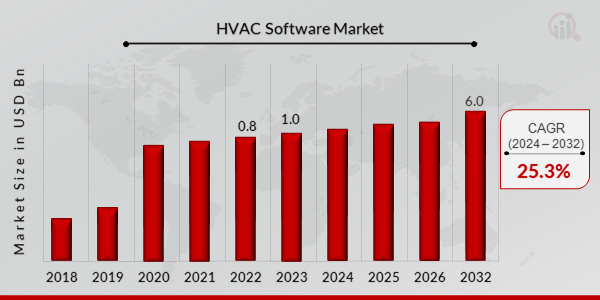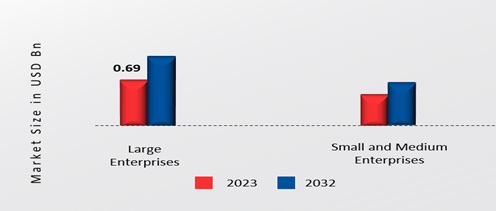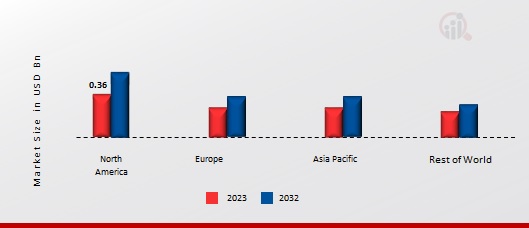HVAC Software Market Overview
HVAC Software Market Size was valued at USD 0.8 Billion in 2022. The HVAC software market industry is projected to grow from USD 1.0 Billion in 2023 to USD 6.0 Billion by 2032, exhibiting a compound annual growth rate (CAGR) of 25.3% during the forecast period (2024 - 2032).
Growing awareness of environmental sustainability and energy conservation drives the demand for HVAC software solutions that facilitate energy-efficient system design, monitoring, and control, helping organizations reduce operational costs and carbon footprint are the key market drivers enhancing the market growth.
Figure 1: HVAC Software Market Size, 2023-2032 (USD Billion)

Source: Secondary Research, Primary Research, MRFR Database and Analyst Review
HVAC software Market Trends
-
Growing demand for energy efficiency the market growth
Market CAGR for the call for energy-green HVAC software keeps soaring as companies and individuals alike are seeking to reduce their carbon footprint and decrease operational costs. There is a growing emphasis on leveraging HVAC software to optimize machine overall performance, limit power wastage, and meet stringent regulatory necessities.
Additionally, with the increasing complexity of HVAC systems, fueled by improvements in generation and the integration of smart building additives, there's an urgent need for sophisticated software program solutions to manage those tricky structures effectively. Modern HVAC systems often function with numerous components, consisting of sensors, actuators, and manipulation algorithms, necessitating complete software platforms to ensure seamless integration, operation, and preservation.
Furthermore, the growing demand for retrofitting existing HVAC systems further drives the adoption of HVAC software answers. As homes age and strength performance requirements evolve, there's a growing want to improve previous HVAC infrastructure to enhance overall performance and decrease electricity consumption. The increasing consciousness of power performance and the provision of government incentives for retrofit projects. HVAC software program plays a critical function in retrofitting initiatives by facilitating accurate power audits, simulation modeling, and overall performance optimization, thereby allowing organizations to reap huge energy savings and environmental advantages. Thus, driving the HVAC software market revenue.
HVAC Software Market Segment Insights
-
HVAC Software Deployment Insights
The HVAC Software Market segmentation, based on Deployment, includes Cloud-Based HVAC Software and Web-based HVAC Software. In 2023, the Cloud-Based HVAC Software segment dominated the market. Cloud-based HVAC software offers unparalleled accessibility and scalability, allowing users to access the software from any location with an internet connection.
-
HVAC software Enterprise Size Insights
The HVAC Software Market segmentation, based on Enterprise Size, includes Large Enterprises, Small and Medium Enterprises. In 2023, the Large Enterprises generated the most income. Large enterprises typically have existing IT infrastructure and enterprise systems in place, such as Enterprise Resource Planning (ERP) software, Building Automation Systems (BAS), and Customer Relationship Management (CRM) platforms.
Figure 2: HVAC Software Market, by Enterprise Size, 2023 & 2032 (USD Billion)

Source: Secondary Research, Primary Research, MRFR Database and Analyst Review
HVAC software Regional Insights
By region, the study provides the market insights into North America, Europe, Asia-Pacific, and the Rest of the World. The North American HVAC software market area will dominate this market, with increasingly stringent regulations and standards regarding energy efficiency, indoor air quality, and environmental impact propelling the adoption of HVAC software, enabling businesses to ensure compliance and avoid penalties.
Further, the major countries studied in the market report are The US, Canada, Germany, France, the UK, Italy, Spain, China, Japan, India, Australia, South Korea, and Brazil.
Figure 3: HVAC SOFTWARE MARKET SHARE BY REGION 2023 (USD Billion)

Source: Secondary Research, Primary Research, MRFR Database and Analyst Review
Europe's HVAC software market accounts for the second-largest market share. Europe has implemented strict regulations and standards aimed at improving energy efficiency and reducing carbon emissions in buildings. HVAC software plays a crucial role in optimizing HVAC system performance ensuring compliance with energy efficiency requirements. Further, the German HVAC software market held the largest market share, and the UK HVAC software market was the fastest-growing market in the European region.
The Asia-Pacific HVAC Software Market is expected to grow at the fastest CAGR from 2024 to 2032. With increasing demand for HVAC systems in these buildings to ensure comfort and productivity, there is a corresponding need for HVAC software to design, simulate, and optimize these systems efficiently. Moreover, China’s HVAC software market held the largest market share, and the Indian HVAC software market was the fastest-growing market in the Asia-Pacific region.
HVAC Software Key Market Players & Competitive Insights
Leading market players are investing heavily in research and development in order to expand their services, which will help the HVAC software market grow even more. Market participants are also undertaking a variety of strategic activities to expand their global footprint, with important market developments including new service launches, contractual agreements, mergers and acquisitions, higher investments, and collaboration with other organizations. To expand and survive in a more competitive and rising market climate, the HVAC software industry must offer cost-effective services.
Manufacturing locally to minimize operational costs is one of the key business tactics used by manufacturers in the global HVAC software industry to benefit clients and increase the market sector. In recent years, the HVAC software industry has offered some of the most significant advantages to homes. Major players in the HVAC software market, including Daikin, Johnson Controls, LG Electronics, Carrier, Trane Technologies, Emerson, Honeywell, Mitsubishi Electric, Samsung, Nortek, Codefied Inc., Dataforma Inc., Fergus Software Limited, FieldEdge, GorillaDesk, and others, are attempting to increase market demand by investing in research and development operations.
Daikin Industries Ltd., centered in Osaka, Japan, is a global chief in the heating, air flow, and aircon (HVAC) employer. With wealthy records spanning nearly a century, considering its founding in 1924, Daikin has installed itself as a pioneer in HVAC technology, known for its modern merchandise and answers. The enterprise's full-size product portfolio includes air conditioners, warmness pumps, chillers, and refrigeration structures, catering to residential, enterprise, and industrial markets internationally. Daikin is devoted to sustainability and environmental responsibility, glaring in its improvement of power-inexperienced products and projects to lessen greenhouse fuel emissions. With a sturdy worldwide presence and a focal point on studies and improvement, Daikin keeps pressuring enhancements in HVAC technology, imparting dependable and sustainable solutions to meet the evolving wishes of its customers.
Johnson Controls, targeted in Cork, Ireland, is a multinational company specializing in building technology and solutions, such as HVAC software, hearth and security solutions, and building automation. With roots dating back to 1885, Johnson Controls has extended popularity and recognition for innovation and excellence inside the building organization. The corporation's HVAC division offers an entire range of services and products, which encompass chillers, air managing gadgets, controls, clever construction, and serving customers across various sectors, including business buildings, healthcare centers, and commercial complexes. Johnson Controls is devoted to sustainability and energy performance, striving to create more wholesome and extra-sustainable environments through its superior construction technology and solutions. With a worldwide presence spanning over one hundred fifty international places and a steady attention to client-centric innovation, Johnson Controls remains a depended-on companion for building owners, facility managers, and HVAC professionals worldwide.
Key Companies in the HVAC software market include
-
Daikin
-
-
LG Electronics
-
Carrier
-
-
Emerson
-
-
Mitsubishi Electric
-
Samsung
-
Nortek
-
Codefied Inc.
-
Dataforma Inc.
-
Fergus Software Limited
-
FieldEdge
-
GorillaDesk
HVAC Software Industry Developments
April 2022: The purpose of the curb-to-curb AR and AI field services solution that XOi Technologies and Daikin Comfort Technologies North America Inc. (Daikin) created together was to increase productivity and profitability through the use of XOi software and workflow automation.
December 2021: Yardi and Motili have announced a merger. Through this integration, Motili will be able to utilise Yardi Voyager's web-based HVAC software solution, which boosts transparency, automates workflow, and optimises services by providing mobile access, integrated end-to-end capabilities, and the ability to manage larger portfolios.
HVAC software Market Segmentation
HVAC software Deployment Outlook
- Cloud-Based HVAC Software
- Web-based HVAC Software
HVAC software Enterprise Size Outlook
- Large Enterprises
- Small and Medium Enterprises
HVAC software Regional Outlook
- North America
- Europe
- Germany
- France
- UK
- Italy
- Spain
- Rest of Europe
- Asia-Pacific
- China
- Japan
- India
- Australia
- South Korea
- Australia
- Rest of Asia-Pacific
- Rest of the World
- Middle East
- Africa
- Latin America
| Report Attribute/Metric |
Details |
| Market Size 2022 |
USD 0.8 Billion |
| Market Size 2023 |
USD 1.0 Billion |
| Market Size 2032 |
USD 6.0 Billion |
| Compound Annual Growth Rate (CAGR) |
25.3% (2024-2032) |
| Base Year |
2023 |
| Market Forecast Period |
2024-2032 |
| Historical Data |
2019- 2022 |
| Market Forecast Units |
Value (USD Billion) |
| Report Coverage |
Revenue Forecast, Market Competitive Landscape, Growth Factors, and Trends |
| Segments Covered |
Deployment, Enterprise Size, and Region |
| Geographies Covered |
North America, Europe, Asia-Pacific, and the Rest of the World |
| Countries Covered |
The US, Canada, Germany, France, UK, Italy, Spain, China, Japan, India, Australia, South Korea, and Brazil |
| Key Companies Profiled |
Daikin, Johnson Controls, LG Electronics, Carrier, Trane Technologies, Emerson, Honeywell, Mitsubishi Electric, Samsung, Nortek, Codefied Inc., Dataforma Inc., Fergus Software Limited, FieldEdge, and GorillaDesk. |
| Key Market Opportunities |
· Rising demand for improved building infrastructure creates opportunities for HVAC software providers. |
| Key Market Dynamics |
· HVAC systems connect with sensors and mobile apps for real-time monitoring and control. |
Frequently Asked Questions (FAQ) :
The HVAC Software Market size was valued at USD 1.0 Billion in 2023.
The global market is projected to grow at a CAGR of 25.3% during the forecast period, 2024-2032.
North America had the largest share in the global market
The key players in the market are Daikin, Johnson Controls, LG Electronics, Carrier, Trane Technologies, Emerson, Honeywell, Mitsubishi Electric, Samsung, Nortek, Codefied Inc., Dataforma Inc., Fergus Software Limited, FieldEdge, and GorillaDesk.
The Cloud-Based HVAC Software category dominated the market in 2023.The Cloud-Based HVAC Software category dominated the market in 2023.
The Large Enterprises had the largest share in the global market.





























